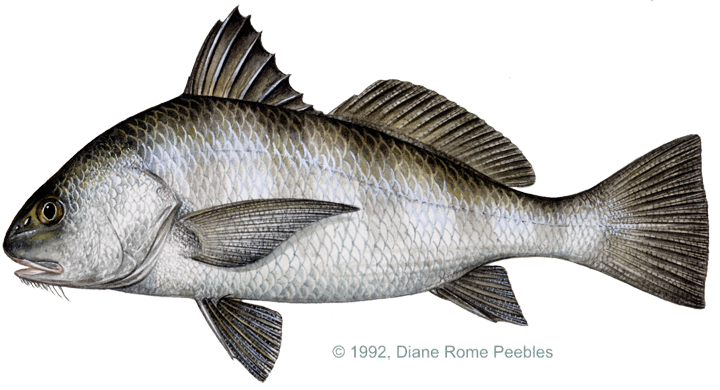Game Fish Identification Reference Guides
Drum, black
(Pogonias cromis)
(Pogonias cromis)

(Linnaeus, 1766); SCIAENIDAE FAMILY; also called drum, sea drum, common drum
Found in the western Atlantic Ocean from Nova Scotia to northern Mexico, including southern Florida, then from southern Brazil to Argentina. An inshore, schooling fish, the black drum is known to inhabit areas near breakwaters, jetties, bridge and pier pilings, clam and oyster beds, channels, estuaries, bays, high marsh areas, and the shorelines over sandy bottoms.
Drums are members of the croaker family (Sciaenidae) which are comprised of 260 species including the weakfish, spotted seatrout, white seabass, Atlantic croaker, and California kingfish. The black drum is distinguished from similar species by the unusually large spine in the anal fin and numerous barbels on the chin. There are large pavement like teeth in the throat that are used to crush shellfish. Unlike the red drum (Sciaenops ocellatus), the black drum has no dark spot on the tail base. Juveniles have 4 or 5 broad, dark vertical bars on the body. They feed on mollusks and crustaceans that they locate in the sand with their sensitive chin barbels.
Drums use their air bladder to create a sound similar to a drum beating. This “drumming” is largely associated with the breeding season and probably assists in locating and attracting members of the opposite sex. The drumming of the males is particularly loud while the sound of the females is softer.
The black drum is sluggish and does not strike quickly or with force, but when hooked, it puts up an exceedingly tough fight. Fishing methods include bottom fishing, casting from boats or shore, or slow trolling. Baits and lures include shrimp, clams, crabs, squid, cut fish, metal jigs, spoons, and weighted bucktails. Small drums of about 10 15 lb (5 7 kg) are said to be good eating, though they are often infested with parasites
Found in the western Atlantic Ocean from Nova Scotia to northern Mexico, including southern Florida, then from southern Brazil to Argentina. An inshore, schooling fish, the black drum is known to inhabit areas near breakwaters, jetties, bridge and pier pilings, clam and oyster beds, channels, estuaries, bays, high marsh areas, and the shorelines over sandy bottoms.
Drums are members of the croaker family (Sciaenidae) which are comprised of 260 species including the weakfish, spotted seatrout, white seabass, Atlantic croaker, and California kingfish. The black drum is distinguished from similar species by the unusually large spine in the anal fin and numerous barbels on the chin. There are large pavement like teeth in the throat that are used to crush shellfish. Unlike the red drum (Sciaenops ocellatus), the black drum has no dark spot on the tail base. Juveniles have 4 or 5 broad, dark vertical bars on the body. They feed on mollusks and crustaceans that they locate in the sand with their sensitive chin barbels.
Drums use their air bladder to create a sound similar to a drum beating. This “drumming” is largely associated with the breeding season and probably assists in locating and attracting members of the opposite sex. The drumming of the males is particularly loud while the sound of the females is softer.
The black drum is sluggish and does not strike quickly or with force, but when hooked, it puts up an exceedingly tough fight. Fishing methods include bottom fishing, casting from boats or shore, or slow trolling. Baits and lures include shrimp, clams, crabs, squid, cut fish, metal jigs, spoons, and weighted bucktails. Small drums of about 10 15 lb (5 7 kg) are said to be good eating, though they are often infested with parasites












